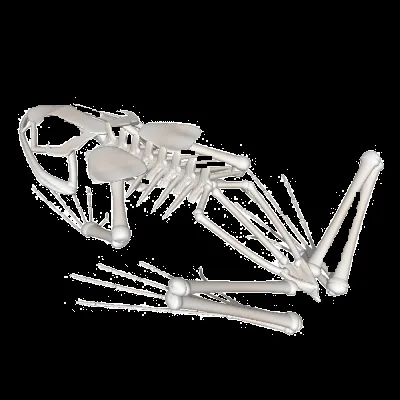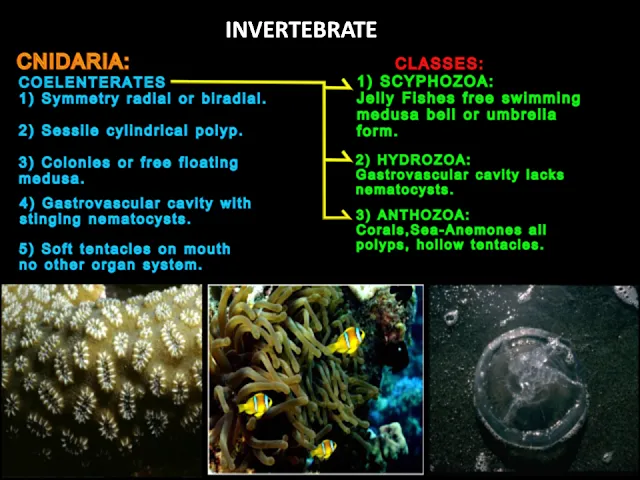Vertebrates:
 |
| Vertebrates Slide |
Vertebrates are those animals with Backbone or Spinal column (Vertebra). These animals have definite skeletal Structure which give them proper shape , size and also protect their Vital Organs (Heart, Lung , brain etc) . Vertebrates have long history on this earth-- more than 500 million years, from the late Cambrian up to today. These first vertebrates lacked jaws, like the living Hagfish and lampreys. Jawed vertebrates appeared 100 million years later in the Silurian.
Vertebrates include most advanced animals on earth like 1) Fish 2) Amphibia 3) Reptile 4) Birds 5) Mammals. Very Few advanced animals are within this group compare to Invertebrates. Definite Skeleton structure give them firm and easy movements on the Planet Earth. Easy and fist movement also help them to move one place to another for the search of Foods, Shelter and Safety etc.These assurance triggers their Evolution rate more higher and higher, Therefore we can find more higher and intelligent animal like Human in this group.
Classification of Vertebrates
 |
| Cartilaginous Fishes Classification Slide |
 |
| Bony Fish Classification Slide |
 |
| Amphibian Animal Classification Slide |
 |
| Reptilian Animal Classification Slide |
 |
| Birds Classification Slide |
 |
| Mammalian Animal Classification Slide |
Some Anatomical Features of Vertebrates:
 |
| Comparative Picture of Vertebrate Brain |
 |
| Anatomy of Fish |
 |
| Skeleton of Frog (Amphibian) |
 |
| Anatomy of Bird |
 |
| Anatomy of Human |
Invertebrate:
 |
| Invertebrate Slide |
Of the million or more animal species in the world, more than 98% are invertebrates. Invertebrates don't have an internal skeleton made of bone. Many invertebrates have a fluid-filled, hydrostatic skeleton, like the jelly fish or worm. Others have a hard outer shell, like insects and crustaceans. There are many types of invertebrates. The most common invertebrates include the protozoa, annelids, echinoderms, mollusks and arthropods. Arthropods include insects, crustaceans and arachnids. In Crustaceans , Mollusca and some species of Insects like Beetles we find some kind of tough covering exoskeleton over their body. Among Invertebrates Octopus are very intelligent animal and have complex neural network.
Some of the first animal fossils appear to be those of invertebrates. 665-million-year-old fossils in the Trezona Formation at Trezona Bore, West Central Flinders, South Australia have been interpreted as being early sponges. Some paleontologists suggest that animals appeared much earlier, possibly as early as 1 billion years ago. Trace fossils such as tracks and burrows found in the Tonian era indicate the presence of triploblastic worms, like metazoans, roughly as large (about 5 mm wide) and complex as earthworms.
Around 453 MYA, animals began diversifying, and many of the important groups of invertebrates diverged from one another. Fossils of invertebrates are found in various types of sediment from the Phanerozoic
Classification of Invertebrates:
 |
| Annelida Classification Slide |
 |
| Arthropoda Classification Slide |
 |
| Cnidaria Classification Slide |
 | ||||||||
| Ctenophora Classification Slide |
 |
| Echinodermata Classification Slide |
 |
| Platyhelminthes Classification Slide |
 |
| Mollusca Classification Slide |
 |
| Nemertinea Classification Slide |
 |
| Porifera Classification Slide |
 |
| Anatomy of an Insect |
Every 3D Pictures in this Classification Post Is Created By Me (Manash Kundu)






















 Online Movies
Online Movies
It's spelled correctly in the text and title, but wrong in all images after the first one; it should be vertebrate with an e, not vertibrate with an i.
ReplyDelete